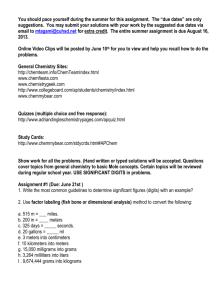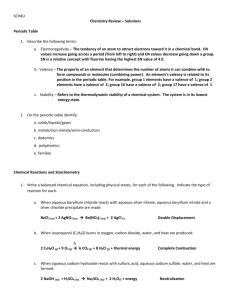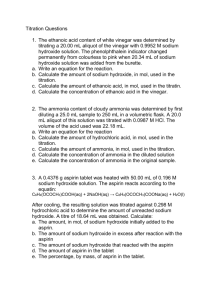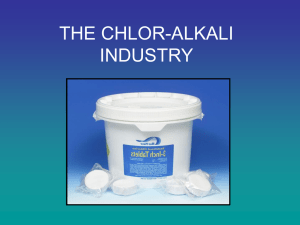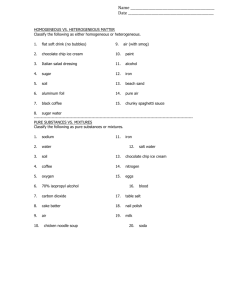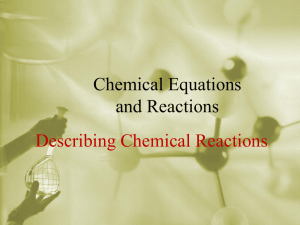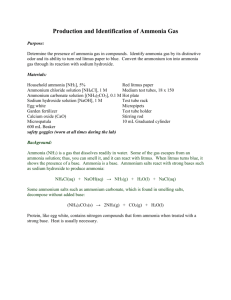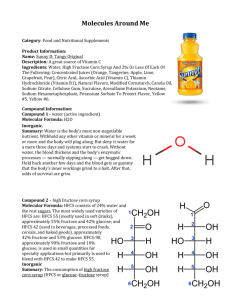Chemistry 1 Review - Garnet Valley School District
advertisement
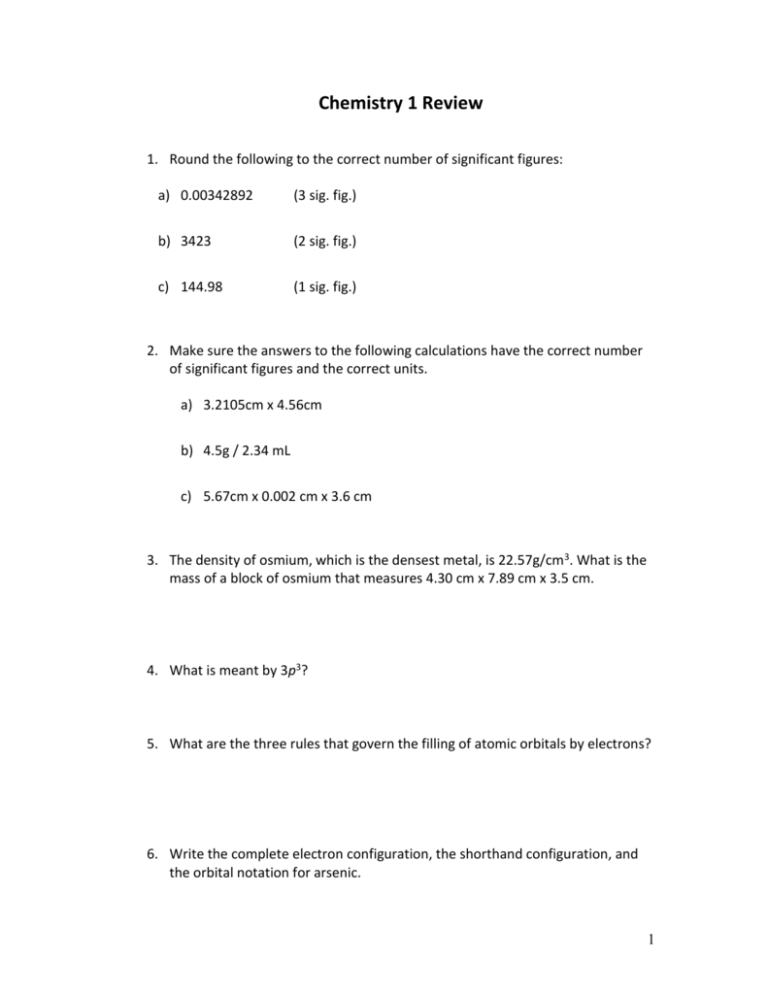
Chemistry 1 Review 1. Round the following to the correct number of significant figures: a) 0.00342892 (3 sig. fig.) b) 3423 (2 sig. fig.) c) 144.98 (1 sig. fig.) 2. Make sure the answers to the following calculations have the correct number of significant figures and the correct units. a) 3.2105cm x 4.56cm b) 4.5g / 2.34 mL c) 5.67cm x 0.002 cm x 3.6 cm 3. The density of osmium, which is the densest metal, is 22.57g/cm3. What is the mass of a block of osmium that measures 4.30 cm x 7.89 cm x 3.5 cm. 4. What is meant by 3p3? 5. What are the three rules that govern the filling of atomic orbitals by electrons? 6. Write the complete electron configuration, the shorthand configuration, and the orbital notation for arsenic. 1 7. There are five naturally occurring isotopes of the element A. The relative abundance and mass of each are as follows: 48.89%, 33.929 amu 27.81%, 35.926 amu 4.11%, 36.927 amu 18.75%, 37.925 amu 0.62%, 39.925 amu Calculate the average atomic mass of A. 8. Write the formulas for the following compounds: a) diphosphorus pentoxide b) cupric phosphate c) calcium fluoride d) nickel nitrite e) silver cyanide f) tin (II) chloride g) magnesium hydroxide 2 9. A solution of barium chloride reacts with a solution of potassium sulfate. Predict the products and write a balanced equation for this reaction. 10. What is the pH of the following solutions: a) [H+] is 3.6 x10-12 b) [H+] is 3.4 x10-5 c) [OH-] is 1.0 x10-7 d) [OH-] is 8.2 x10-3 e) [OH-] is 2.1 x10-10 11. Are the solutions in question 4 neutral, acidic, or basic? 12. Calculate the percent composition of Cu3(PO4)2 13. How many moles are there in 0.34L of nitrogen gas…. a) At STP? b) At 1.3 atm and 335°C? 14. In a solution the concentration of hydrogen ions, [H+], is 1x10-12. What is the concentration of hydroxide ions, [OH-]? Is the solution neutral, acidic or basic? 3 15. Classify these processes as exothermic or endothermic. a) burning alcohol b) photosynthesis c) baking a potato 16. A sample of oxygen at 24°C has a volume of 1.32 L and a pressure of 756mmHg. What is the mass of the oxygen? 17. Why does ammonia have a much higher boiling point (-33 C) than methane (-164C) although their molar masses are almost the same? 18. How many molecules are there in: a) 0.86 moles of CH4 b) 46.3 g of SO3 c) 71.85 g of C6H12O6 19. How many H atoms in 4.03 g of ammonia? 4 20. How much copper (I) chloride can be produced beginning with 75.0g of copper (I) oxide? Cu2O + 2HCl 2CuCl + H2O 21. The unbalanced equation for the reaction of ammonia and chlorine gas is NH3(g) + Cl2(g) NH4Cl (s) + NCl3(g) 45.6g of ammonia reacts with 68.5 g of chlorine. a) Balance the equation. b) Which is the limiting reagent? c) What is the theoretical yield of ammonium chloride? 22. 34 mL of nitrogen gas is collected over water at 20.0°C. The barometric pressure is 1.06 atm. What is the pressure of the dry nitrogen? Calculate the mass of the dry nitrogen. Vapor pressure of water at 20.0°C is 17.5 mm Hg. 5 23. Which of the following substances dissolve in water? Why? a) CH4 b) MgSO4 c) Cane sugar 24. How much 0.300 M H2SO4 is needed to neutralize 34.0 mL of a 0.250 M solution of NaOH? 25. The formulas CaCl2 and CuCl2 look very similar. What is the name for each compound? Why do we name them differently? 26. What type of reactions are the following? a) Na2O (s) + CO2 (g) Na2CO3 (s) b) 3 Pb(NO3)2 (aq) + 2 (NH4)3PO4 (aq) 6 NH4NO3 (aq) + Pb3(PO4)2 (s) c) 2 C4H10 (l) + 13 O2 (g) 8 CO2 (g) + 10 H2O (g) d) 2 NaClO3 (s) 2 NaCl (s) + 3 O2 (g) e) 3 Mg (s) + 2 FeCl3 (aq) 3 MgCl2 (aq) + 2 Fe (s) f) H2SO4 (aq) + Ba(OH)2 (aq) BaSO4 (s) + 2 H2O (l) 6 27. If a 1.00 kg block of ice at -28.0C is heated until it is water at 23.0C, how much energy (in Joules) is required? 28. Find the empirical formula of each compound from its % composition. a) 65.2% Sc and 34.8% O b) 52.8% Sn, 12.4% Fe, 16.0% C, and 18.8% N. 29. Balance this equation and write the net ionic equation. Ag2SO4 (aq) + AlCl3 (aq) AgCl (s) + Al2(SO4)3 (aq) 30. What is the volume of a 0.400 M solution containing 256.8 g of glucose (C6H12O6)? 7 31. If 8.69 L propane gas burns in excess oxygen, how many moles of carbon dioxide will be produced? Assume STP. C3H8 + O2 H2O + CO2 (unbalanced) 32. Calculate the molar mass of the following compounds a) Na2CrO4 b) Al(NO3)3 33. Predict the product, complete and balance the equation, then write the net ionic equation for this reaction. Aqueous copper (II) chloride is added to aqueous ammonium chromate. 34. If a clear saturated solution of sodium nitrate is cooled, what change(s) might you observe? 35. When 84.8g of iron (III) oxide reacts with an excess of carbon monoxide, 54.3g of iron is produced. What is the percent yield of this reaction? Fe2O3 (s) + 3CO (g) 2Fe (s) + 3CO2 (g) 8 36. The unbalanced equation for the reaction of sodium oxide and water is Na2O s) + H2O (l) NaOH (aq) 18.7 g of sodium oxide (Na2O) reacts with 32.4g of water. a) Balance the equation. b) Which is the limiting reagent? c) When the reaction is complete, how much of the excess reagent is remaining? d) What is the theoretical yield of sodium hydroxide? 37. How many grams of K2CO3 are needed to prepare 225 mL of a 0.450 M solution? 38. Calculate the number of grams of solute required to make 150 mL of 4.0% MgCl2 (m/v). 39. 15.0mL of 0.600 M Mg(OH)2 neutralized 65.0mL of HNO3. Determine the concentration of the acid. 40. You have the following stock solution available: 4.00 M KNO3. Calculate the volume you must dilute to make 125 mL of 0.650 M KNO3. 9 41. In an experiment, 367g of metal at 100.°C is dropped into 150. g of water at 14.0°C. If the temperature of the water rises to 23.0°C, what is the specific heat capacity of the metal? 42. A company producing ammonia did a trial reaction using 10.0 L of nitrogen at 450. °C and 16.3 atm. The reaction produced 11.23 g of ammonia, NH3. Do you think these reaction conditions produced a high enough percent yield to make the new process economically acceptable? Show all work. N2 (g) + 3H2 (g) 2NH3 (g) 43. A vial contains 0.500g of an unknown monoprotic acid. How would you determine the molar mass of the acid using a solution of 0.120 M sodium hydroxide and the technique of titration? a) Lab equipment b) Procedure c) Measurements recorded d) Calculations 10 44. Draw a molecular level diagram showing a solid, a liquid, and a gas. 45. Draw a molecular level diagram to illustrate the difference between an atomic element, a molecular element, a compound, and a mixture. 46. Draw a molecular level diagram to illustrate an ionic substance dissolving in water. 47. Draw a molecular level diagram to illustrate vapor pressure. 11 48. Draw a molecular level diagram to illustrate the difference between a neon atom, a fluorine atom, a sodium atom, a fluorine ion, and a sodium ion. 49. A solution of hydrochloric acid reacts with a solution of potassium hydroxide. a) Predict the products and write a balanced equation for this reaction. b) Draw a molecular level diagram to illustrate the net ionic equation for this reaction. 50. Sodium hydrogen carbonate is often used in baking. When it decomposes it produces water vapor, carbon dioxide and sodium carbonate. Write a balanced equation for this reaction and then draw a molecular level diagram to illustrate the reaction. 12

